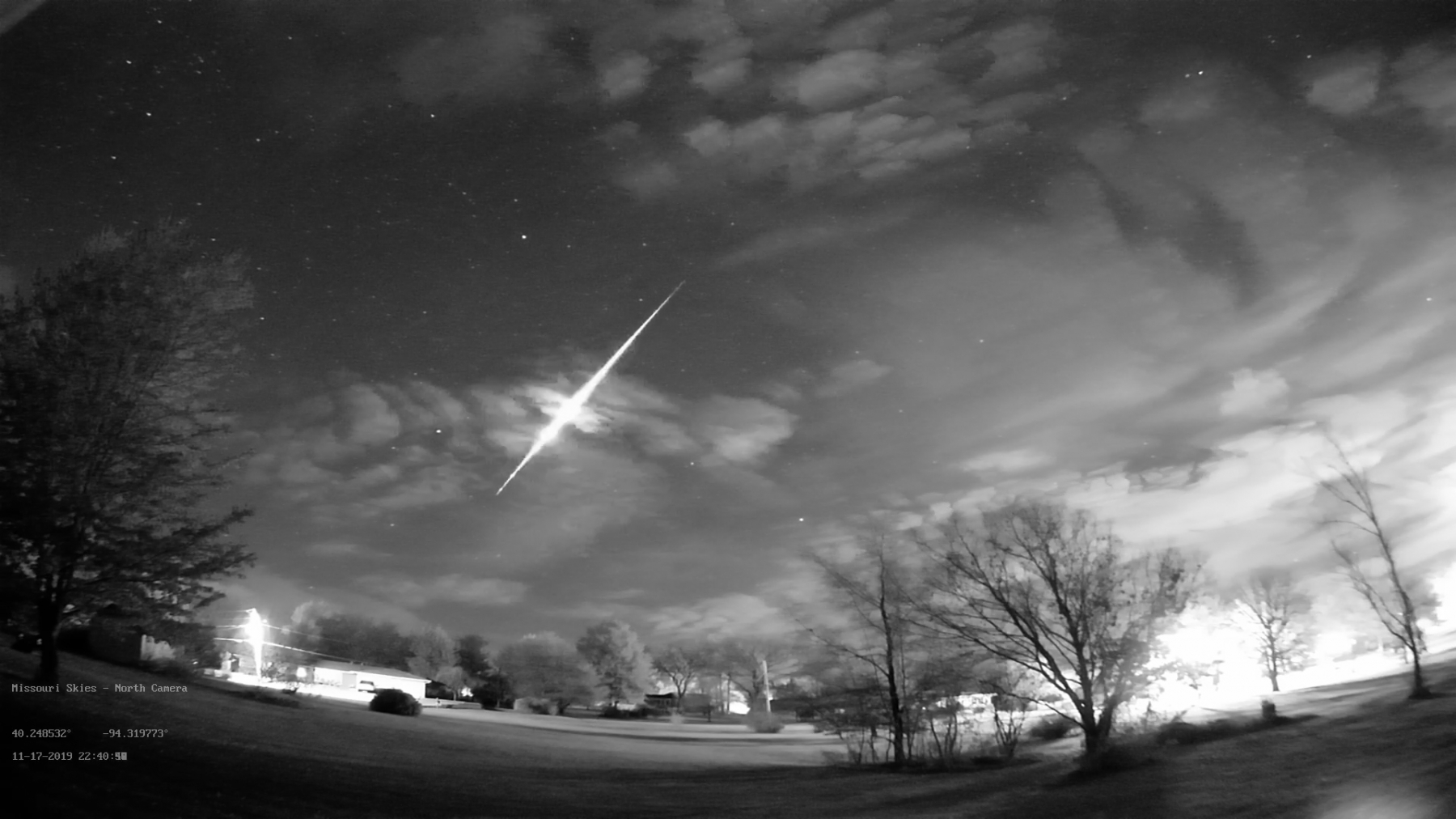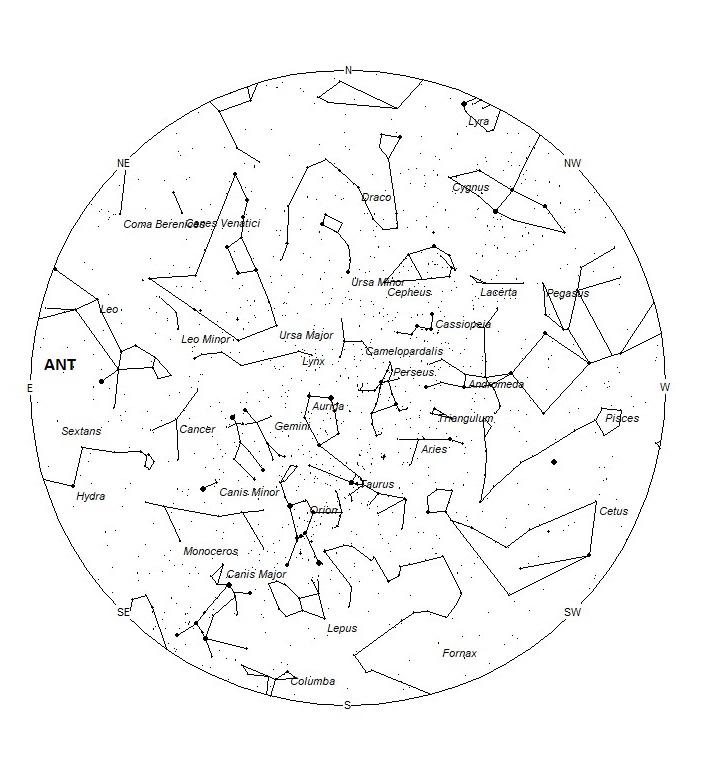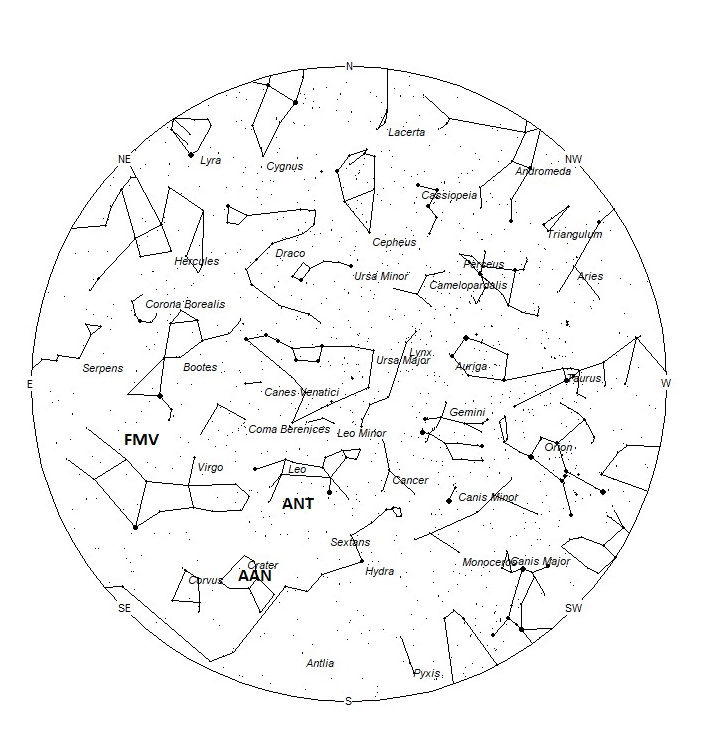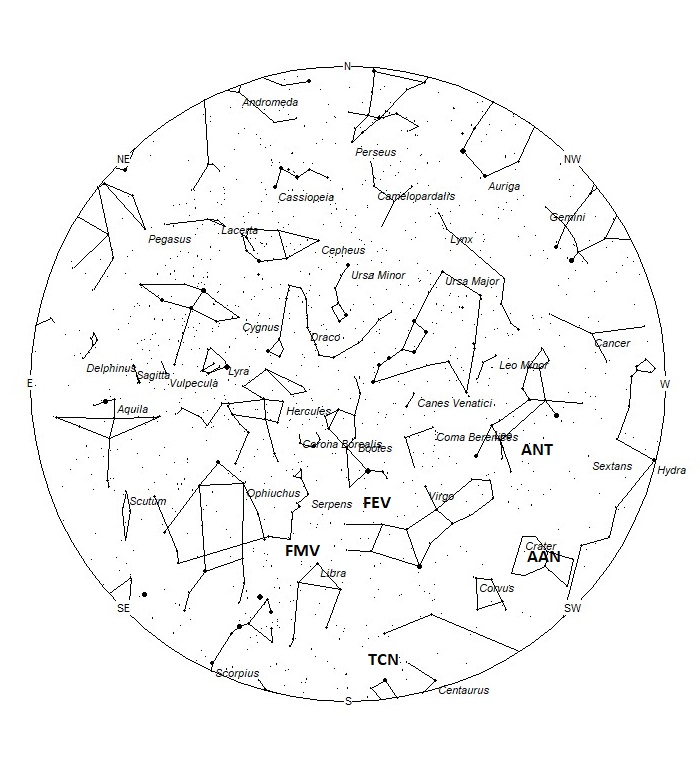
During this period the moon reaches its last quarter phase on Saturday February 15th. At this time the moon will lie 90 degrees west of the sun and will rise near 01:00 local standard time (LST). These conditions are fine for the slow evening hours when the moon lies below the horizon. The more active morning hours will have interference from the moon but one can still obtain useful data as long you face away from the lunar glare. As the week progresses the waning crescent moon will rise later in the morning, allowing less interference during these more active hours. The estimated total hourly meteor rates for evening observers this week is near 2 no matter your location. For morning observers the estimated total hourly rates should be near 5 as seen from mid-northern latitudes (45N) and 10 as seen from tropical southern locations (25S). The actual rates will also depend on factors such as personal light and motion perception, local weather conditions, alertness and experience in watching meteor activity. Morning rates are reduced during this period due to moonlight. Note that the hourly rates listed below are estimates as viewed from dark sky sites away from urban light sources. Observers viewing from urban areas will see less activity as only the brighter meteors will be visible from such locations.
The radiant (the area of the sky where meteors appear to shoot from) positions and rate s listed below are exact for Saturday night/Sunday morning February 15/16. These positions do not change greatly day to day so the listed coordinates may be used during this entire period. Most star atlases (available at science stores and planetariums) will provide maps with grid lines of the celestial coordinates so that you may find out exactly where these positions are located in the sky. A planisphere or computer planetarium program is also useful in showing the sky at any time of night on any date of the year. Activity from each radiant is best seen when it is positioned highest in the sky, either due north or south along the meridian, depending on your latitude. It must be remembered that meteor activity is rarely seen at the radiant position. Rather they shoot outwards from the radiant so it is best to center your field of view so that the radiant lies at the edge and not the center. Viewing there will allow you to easily trace the path of each meteor back to the radiant (if it is a shower member) or in another direction if it is a sporadic. Meteor activity is not seen from radiants that are located below the horizon. The positions below are listed in a west to east manner in order of right ascension (celestial longitude). The positions listed first are located further west therefore are accessible earlier in the night while those listed further down the list rise later in the night.
These sources of meteoric activity are expected to be active this week.
.
The center of the large Anthelion (ANT) radiant is currently located at 10:40 (160) +08. This position lies in southern Leo, 3 degrees southeast of the 4th magnitude star known as rho Leonis. Due to the large size of this radiant, Anthelion activity may also appear from Sextans as well as Leo. This radiant is best placed near 0200 local summer time (LST), when it lies on the meridian and is located highest in the sky. Rates at this time should be near 1 per hour no matter your location. With an entry velocity of 30 km/sec., the average Anthelion meteor would be of slow velocity.
The last of the alpha Antliids (AAN) are expected this weekend from a radiant located near 11:22 (171) -15. This position actually lies in central Crater, just east of the 4th magnitude star known as delta Crateris. This radiant is best placed near 0300 LST, when it lies on the meridian and is located highest in the sky. Rates are expected to be less than 1 per hour no matter your location. With an entry velocity of 45 km/sec., the average meteor from this source would be of medium velocity.
The last of the February Epsilon Virginids (FEV) are also expected this weekend from a radiant located at 14:08 (212) +06, which places it in northern Bootes, 5 degrees north of the 4th magnitude star known as tau Virginis. These meteors would be best seen near 0500 LST when the radiant lies highest above the horizon. Rates are expected to be less than 1 per hour during this period. These meteors are equally well seen from either hemisphere. These meteors encounter the atmosphere at 63 km/sec., which would produce mostly swift meteors.
After studies of the IMO video database provided by cameras located in Australia, Sirko Molau has determined that two more of the Centaurid radiants belonging to the southern hemisphere summer Velid-Crux-Centaurus complex may be distinguished by visual observers. These positions differ from those listed in the IAUs Meteor Data Center so actual shower members may not line up perfectly with the positions given here. The lack of cameras and actual data from the southern hemisphere prevents us from provided better parameters for these far southern radiants. The first of these radiants, the omega Centaurids (OCA) may be seen from February 12-15 with maximum occurring on the 14th. At maximum the radiant is predicted to be near 13:16 (199) -55. This position lies in southern Centaurus, 4 degrees southwest of the 2nd magnitude star known as Epsilon Centauri. The MDC position lies in the southern portion of the Centaurus between Pi Centauri and Gacrux (Gamma Crucis). These meteors are best seen during the last hour prior to dawn when the radiant lies highest above the horizon in a dark sky. Maximum rates are not known but expected to be less than 1 per hour as seen from the southern hemisphere. These meteors are not visible north of 35N latitude. They are best seen from the southern tropics where the radiant rises high into the sky and the summer nights are longer than they are at more southern locations. At 48 km/sec. the Omega Centaurids would produce meteors with average velocities.
The 2nd of these weak Centaurid radiants are the theta Centaurids (TCN). This radiant is also active February 12-16 with maximum occurring on the 14th. This activity may actually be detected by observers situated at mid-northern latitudes as the position lies near 13:56 (209) -29. This position lies near the Centaurus-Hydra border, 4 degrees southwest of the 3rd magnitude star known as Pi Hydrae. The MDC position lies 11 degrees further south between the stars Theta and Nu Centauri. These meteors are best seen during the last hour prior to dawn when the radiant lies highest above the horizon in a dark sky. Maximum rates are not known but expected to be less than 1 per hour as seen from the southern hemisphere. Although this source is visible from most of the northern hemisphere, this radiant are best seen from the southern tropics where the radiant rises higher into the sky. At 65 km/sec. most of the Theta Centaurids would produce meteors with fast velocities.
The alpha Centaurids (ACE) are active from February 2-19, with maximum activity occurring on February 9. The radiant is currently located at 14:38 (220) -61. This position lies in southeastern Centaurus, just west of the zero magnitude star known as Rigel Kentaurus (alpha Centauri). Due to the southern declination of this radiant, these meteors are not well seen in the northern hemisphere. Current rates are expected to be near 1 for those in the southern hemisphere and less than 1 for those located north of the equator. These meteors are best seen during the last hour prior to dawn when the radiant lies highest above the horizon in a dark sky At 56 km/sec. the alpha Centaurids would produce mostly swift meteors.
The February Mu Virginids (FMV) were discovered by Damir Šegon and the Croatian Meteor Network team based on studying SonotaCo and CMN observations (SonotaCo 2007-2011, CMN 2007-2010). These meteors are active from February 17 through March 5 with maximum activity occurring on February 26. The current radiant position lies near 15:44 (236) -06, which actually places it in northeastern Libra, 3 degrees 3 degrees southwest of the 4th magnitude star known as mu Serpentis. Rates are expected to be less than 1 per hour no matter your location. These meteors are best seen during the last hour prior to dawn when the radiant lies highest above the horizon in a dark sky At 62 km/sec. the February Mu Virginids would produce mostly swift meteors.
As seen from the mid-northern hemisphere (45N) one would expect to see approximately 7 sporadic meteors per hour during the last hour before dawn as seen from rural observing sites. Evening rates would be near 1 per hour. As seen from the tropical southern latitudes (25S), morning rates would also be near 10 per hour as seen from rural observing sites and 2 per hour during the evening hours. Locations between these two extremes would see activity between the listed figures. Rates are reduced during the morning hours due to moonlight.
The list below offers the information from above in tabular form. Rates and positions are exact for Saturday night/Sunday morning except where noted in the shower descriptions.
| SHOWER | DATE OF MAXIMUM ACTIVITY | CELESTIAL POSITION | ENTRY VELOCITY | CULMINATION | HOURLY RATE | CLASS |
| RA (RA in Deg.) DEC | Km/Sec | Local Standard Time | North-South | |||
| Anthelion (ANT) | – | 10:40 (160) +08 | 30 | 01:00 | 2 – 2 | II |
| alpha Antliids (AAN) | Feb 01 | 11:22 (171) -15 | 45 | 02:00 | <1 – <1 | IV |
| omega Centaurids (OCA) | Feb 14 | 13:16 (199) -55 | 48 | 04:00 | <1 – <1 | IV |
| theta Centaurids (TCN) | Feb 14 | 13:56 (209) -29 | 65 | 05:00 | <1 – <1 | IV |
| February Epsilon Virginids (FEV) | Feb 03 | 14:08 (212) +06 | 64 | 05:00 | <1 – <1 | IV |
| alpha Centaurids (ACE) | Feb 09 | 14:40 (220) -61 | 56 | 06:00 | <1 – 1 | II |
| February mu Virginids (FMV) | Feb 26 | 15:44 (236) -06 | 65 | 07:00 | <1 – <1 | II |







 You saw something bright and fast? Like a huge shooting star? Report it: it may be a fireball.
You saw something bright and fast? Like a huge shooting star? Report it: it may be a fireball.  You counted meteors last night? Share your results with us!
You counted meteors last night? Share your results with us!  You took a photo of a meteor or fireball? You have a screenshot of your cam? Share it with us!
You took a photo of a meteor or fireball? You have a screenshot of your cam? Share it with us!  You caught a meteor or fireball on video? Share your video with us!
You caught a meteor or fireball on video? Share your video with us!
One comment
A big fireball was seen the february 18, 2020 over center of Mexico. Was reported in several news media: https://www.bbc.com/mundo/noticias-america-latina-51555096
Everyone called “meteorite”, but was not detected a crater.